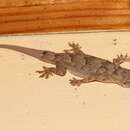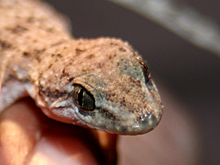en
names in breadcrumbs


Philippine lizards of the family Gekkonidae comprise 49 species (Taylor, 1915, 1922; Brown and Alcala, 1978) in 10 genera: Gehyra (1), Gekko (13), Hemidactylus (5), Hemiphyllodactylus (2), Lepidodactylus (6), Luperosaurus (8), Ptychozoon (1), Pseudogekko (4), and Cyrtodactylus (9), (Brown et al., 2007, 2010a, 2011; Welton et al., 2009, 2010a, 2010b; Zug, 2011). An amazing percentage of these species are endemic to the Philippines archipelago (roughly 85%; Brown et al., 2011). Several of the recently described gekkonids in the Philippines were discovered only recently as part of ongoing surveys around the archipelago. Recent phylogenetic studies focused on Philippine gekkonids (Siler et al., 2010; Welton et al., 2010a,b) have resulted in the observation of high levels of genetic diversity among populations of widespread species, an indication that the country's gecko diversity may still be greatly underestimated.
Two genera of "house" geckos are currently recognized to occur in the Philippines (Gehyra and Hemidactylus). Prior to the recent study by Mahony et al. (2009), Hemidactylus platyurus was recognized to be a member of the genus Cosymbotus; however, numerous studies over the years have indicated the species' close affinity to the genus Hemidactylus. One species of Gehyra (Gehyra mutilata) and five species of Hemidactylus (Hemidactylus brookii, Hemidactylus frenatus, Hemidactylus garnoti, Hemidactylus platyurus, Hemidactylus stejnegeri) are recognized to occur in the Philippines. Several species (Gehyra mutilata Hemidactylus Cosymbotus, and Hemidactylus franatus) are incredibly common and widespread across the archipelago, often being found in disturbed habitats and on the buildings and houses in residential areas. At night, large numbers of individuals of all three of these species can be observed preying on insects near light fixtures. No phylogenetic studies have investigated whether any of these widespread species represent unique lineages in the Philippines.
Dorsal tubercles numerous, large but not uniform in size, conical to rounded and keeled, in 14 to 18 uneven rows at midboy; seven to nine wide scansors (all but the terminal and basal one very deeply notched or divided) beneath the fourth toe; scansors covering the distal 3/4 to 4/5 of the toe; compressed, terminal phalanges of inner toe extending well beyond the dilated portion when depressed; five to eight pores in males covering the lateral part of the preanal region and the basal half of the ghigh on either side (10 to 16 in the combined series). (Text taken from Brown and Alcala, 1978)
This species has been reported from the islands of Mindanao, Bacoor, and Luzon in the Philippines.
In the Philippines, this species is currently associated with the Luzon and Mindanao Pleistocene Aggregate Island Complexes (PAIC; Brown and Diesmos, 2002).
49.5-63.6 mm SVL (Brown and Alcala, 1978)
restricted to Borneo (Smith, 1935; Brown and Alcala, 1978); syntypes stored in the British Museum; BMNH 1947.3.6.47-49 (syntypes)
Hemidactylus brookii, also known commonly as Brooke's house gecko and the spotted house gecko, is a widespread species of lizard in the family Gekkonidae.
The specific name, brookii, is in honor of British adventurer James Brooke.[1]
Snout somewhat longer than the distance between the eye and the ear-opening, nearly twice the diameter of the orbit; forehead concave; ear-opening small, oval, vertical, about one third the diameter of the eye; on the occiput very small round tubercles. Rostral quadrangular, with a median cleft; nostril bordered by the rostral, the first upper labial and three nasals, the upper not in contact with its fellow. Eight to ten upper and seven to nine lower labials; mental large, triangular; two or three pair of chin-shields, median forming - a suture. Scales of the throat granular. Body covered with small granules, intermixed with large keeled trihedral tubercles, arranged in 16-20 longitudinal series, the keels of the outer ones indistinct; the diameter of the largest tubercles on the flanks exceeds the diameter of the ear-opening. Ventral scales larger than those on the throat, cycloid, imbricate. Male with 7-20 femoral pores on each side. Tail depressed, annulate, with rows of 8 or 6 spine-like tubercles, below with a series of transversely dilated plates. Limbs granular, the upper part of the hind limb with large keeled tubercles; digits free, dilated, the free distal joint long, 3-6 lamellae under the inner, 6-8 under the median toes.
Yellowish-brown above with irregular dark spots; one or two dark lines on the side of the head, passing through the eye; lips with dark bars. Lower parts white; all the scales finely dotted with dark brown. Young specimens have cross lines of white tubercles on the back; those on the tail all white.[2]
Length of head and body 58 mm.; tail 60 mm.

Hemidactylus brookii, also known commonly as Brooke's house gecko and the spotted house gecko, is a widespread species of lizard in the family Gekkonidae.